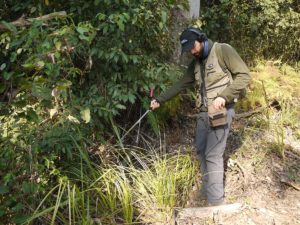
We caught up with recent arrival Dr Bruno Buzatto, Flinders’ new lecturer in Terrestrial Ecology, to chat about his work tracking evolutionary changes in small arachnids and why his days begin with a quest to tire an energetic dog.
What is your role and what does your work focus on?
I’ve just started as a new Lecturer in Terrestrial Ecology, in a balanced role that includes teaching and research. With teaching, I’ll start contributing in the second semester on a topic called Evolution of Biological Diversity and another topic on Statistics and Research Design for Honours students.

On the research side, I’m really interested in behavioural ecology and evolution of terrestrial invertebrates, especially insects and arachnids. My research has focused quite a bit on using bulb mites, which are tiny arachnids, as a model system to study evolution in the lab. These animals have a very short life cycle, so I have used them in artificial selection in the lab, and I can track evolutionary changes in their populations in the lab within a few months, which is fascinating.
I’ve also done research on the reproductive biology of dung beetles, spiders, damselflies, earwigs, and many more different groups of insects. More recently, I received funding by National Geographic to start a study tracking the movements of male funnel-web spiders, which is a very interesting project that I want to expand in the near future.
What journey brought you to this point in your career?
I’m originally from Brazil, and moved to Australia in 2009 to do my PhD at the University of Western Australia in Perth. I worked as a postdoctoral research associate at UWA for five years, after which I moved to Macquarie University in Sydney, where I was based for two years, coordinating a large first-year biology topic.
Before starting at Flinders University, I moved back to Perth and spent two years working part-time as an environmental consultant, focusing on the biodiversity of short-range endemic invertebrates and subterranean fauna of the Pilbara and Goldfields regions of Western Australia. This steered some of my research towards conserving terrestrial invertebrates. A highlight of this research was discovering the first true millipede — the first species ever with more than 1,000 legs!
What do you love most about your work?
I’m fascinated by the animals I study, so I simply love watching them and trying to understand their behaviours. Whether I’m in the lab and looking at mites through a microscope, or in the field and watching a spider under the light of my head torch, I take so much pleasure in seeing these little animals go about their daily lives, especially their mating rituals.
I’m also a very enthusiastic lecturer, and I love teaching large classes full of students. For me, teaching becomes even more rewarding when I can share my enthusiasm for biology with students. It’s always very motivating to see students demonstrate genuine interest for the topic. I always end up learning many new things with the students as well, which is fantastic.
What is something you would like people to know about your role?
I’m completely approachable, and it’s a big part of my job to mentor and supervise students, and establish collaborations with other researchers within Flinders and in other institutions. Moreover, science communication and outreach are part of being a lecturer. So, I love it when people knock on my door, call me, or send me an email asking about my research, or making any enquiries about biology in general. I’m always happy to be contacted and to try and help.
What is something you are most proud of?
I’m certainly proud of some articles I published about my research, but I’m especially proud of student feedback I’ve received in recent years. Nothing has made me feel more useful and helpful than when students respond to me, either in formal feedback forms or in personal emails. I’m so grateful to all students who invested the time in telling me what they thought of my teaching practice.
What does a normal day look like for you?
About 9 months ago, my partner and I got a rescue dog. Luna is a Kelpie-cross who doesn’t have an off switch, so a normal day always starts by taking her to an off-lead dog area, so she can burn off some of that energy before I head into work. We only recently moved to Adelaide, so we’ve been spending most of our time settling in; finding a rental home, getting it furnished. We moved to Glenalta, so I’m experimenting with the idea of cycling to Flinders. The route to work is quite easy, but the way home is another story! It’s a bit too steep for me to do every day.
How do you like to relax or spend your spare time?
I’m really enthusiastic about outdoor sports, so I love to spend my spare time rock-climbing, mountain biking and hiking or running on trails. My partner and I are also both naturalists, so we also love to go out looking for bugs and birds, and sometimes scuba diving to see marine life. I’m also obsessed with a Brazilian music style called “choro”, which has many similarities to some forms of jazz, and I love to practice at home. Sometimes, friends and I will play at music festivals.

